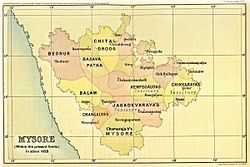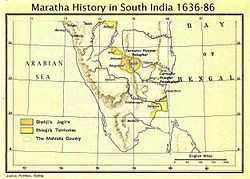Kanthirava Narasaraja I
| Kanthirava Narasaraja I | |
|---|---|
| King of Mysore | |
|
Kanthirava Narasaraja I, ruler of the principality of Mysore, 1638–1659. | |
| Reign | 1638–1659 |
| Religion | Hindu |

Narasa Raja Wodeyar I (1638–1659) was the Wodeyar ruler of Mysore (a principality or petty kingdom in southern India) from 1638 to 1659.
Early years
The previous significant ruler, Chamaraja V, was succeeded by his uncle, who in turn was quickly poisoned on the orders of the Dalavoi (Prime Minister), Vikramaraya, within a year of becoming the wodeyar.[1] The 23-year-old Kanthirava Narasaraja I (also known as Ranadhira Kanteerava Narasa Raja Wodeyar), who had earlier been adopted by the widow of Raja I, became, in 1638, the new Wodeyar of Mysore.Before becoming king of mysore,he lived in terakanambi near gundalpet,chamarajanagar district.[1]
Rule
(1399–present) | |
| Under Vijayanagara Empire
(1399–1565) | |
| Yaduraya Wodeyar | (1399–1423) |
| Chamaraja Wodeyar I | (1423–1459) |
| Timmaraja Wodeyar I | (1459–1478) |
| Chamaraja Wodeyar II | (1478–1513) |
| Chamaraja Wodeyar III | (1513–1553) |
| Independent Wodeyar Kings
(1565–1761) | |
| Timmaraja Wodeyar II | (1553–1572) |
| Chamaraja Wodeyar IV | (1572–1576) |
| Chamaraja Wodeyar V | (1576–1578) |
| Raja Wodeyar I | (1578–1617) |
| Chamaraja Wodeyar VI | (1617–1637) |
| Raja Wodeyar II | (1637–1638) |
| Narasaraja Wodeyar I | (1638–1659) |
| Dodda Devaraja Wodeyar | (1659–1673) |
| Chikka Devaraja Wodeyar | (1673–1704) |
| Narasaraja Wodeyar II | (1704–1714) |
| Krishnaraja Wodeyar I | (1714–1732) |
| Chamaraja Wodeyar VII | (1732–1734) |
| Krishnaraja Wodeyar II | (1734–1766) |
| Under Haider Ali and Tipu Sultan
(1761–1799) | |
| Krishnaraja Wodeyar II | (1734–1766) |
| Nanjaraja Wodeyar | (1766–1772) |
| Chamaraja Wodeyar VIII | (1772–1776) |
| Chamaraja Wodeyar IX | (1776–1796) |
| Under British Rule
(1799–1950) | |
| Krishnaraja Wodeyar III | (1799–1868) |
| Chamaraja Wodeyar X | (1881–1894) |
| Krishnaraja Wodeyar IV | (1894–1940) |
| Jayachamaraja Wodeyar | (1940–1950) |
| (Monarchy abolished)
Titular monarchy (1950–present) | |
| Jayachamaraja Wodeyar | (1950–1974) |
| Srikanta Wodeyar | (1974–2013) |
| Yaduveera Chamaraja Wadiyar | (2015–present) |

Soon after his accession, he was called on to defend Srirangapatna against the invasions of the Adil Shahis of Bijapur, a defense which he mounted with great loss for the enemy.[2] In the fashion of the two wodeyars before him, he continued to expand the Mysore dominions.[1] This included taking Satyamangalam from the Nayaks of Madurai in the south, unseating the Chingalvas from their base in Piriyapatna in the west, gaining possession of Hosur (near Salem) to the north and delivering a major blow at Yelahanka to the rule of Kempe Gowda of Magadi, from whom a large tribute was exacted.[1] Kanthirava Narasaraja I was also the first wodeyar of Mysore to create the symbols associated with royalty, such as establishing a mint and issuing coins named Kanthiraya (corrupted to "Canteroy") after him.[1] These were to remain a part of Mysore's "current national money" for well over a century.[1] Kanthirava Narasaraja I, who married ten times, died on 31 July 1659, at the age of 44. At his funeral, all his surviving wives committed sati.
Early Christianity in Mysore
Catholic missionaries, who had arrived in the coastal areas of southern India—the Malabar coast, the Kanara coast, and the Coromandel coast—starting early in the sixteenth century, did not begin work in land-locked Mysore until halfway through the seventeenth.[3] The Mysore mission was established in Srirangapatna in 1649 by Leonardo Cinnami, an Italian Jesuit from Goa.[3] Although a few years later Cinnami was expelled from Mysore on account of opposition in Kanthirava's court, the ruler himself was not seen by the Jesuits as unsympathetic, and towards the end of Kanthirava's rule, Cinnami returned to establish missions in half a dozen locations.[3] During his second stay Cinnami obtained permission to convert Kanthirava's subjects to Christianity; however, he was successful mostly in the eastern regions of Kanthirava's dominions, regions that later became part of the Madras Presidency of British India.[3] According to (Subhrahmanyam 1985, p. 209), "Of a reported 1700 converts in the Mysore mission in the mid-1660s, a mere quarter were Kannadigas (Kannada language speakers), the rest being Tamil speakers from the western districts of modern-day Tamil Nadu, ..."[3]
See also
- History of Mysore and Coorg, 1565–1760
Notes
- ↑ 1.0 1.1 1.2 1.3 1.4 1.5 Imperial Gazetteer of India: Provincial Series 1908, p. 20
- ↑ Imperial Gazetteer of India: Provincial Series 1908, p. 20, Michell 1995, p. 20
- ↑ 3.0 3.1 3.2 3.3 3.4 Subrahmanyam 1989, pp. 208–209
References
- Imperial Gazetteer of India: Provincial Series (1908), Mysore and Coorg, Calcutta: Superintendent of Government Printing. Pp. xvii, 365, 1 map.
- Michell, George (1995), Architecture and Art of Southern India: Vijayanagara and the successor states: 1350–1750, Cambridge and New York: Cambridge University Press. Pp. 250, ISBN 0-521-44110-2
- Subrahmanyam, Sanjay (1989), "Warfare and state finance in Wodeyar Mysore, 1724–25: A missionary perspective", Indian Economic Social History Review 26 (2): 203–233, doi:10.1177/001946468902600203
